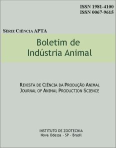Behavior of four different mixed pastures in Central Cerrado of São Paulo State. I. Botanical composition, amount and quality of forage
Abstract
The presente essay was carried Out from January, 79 up to January, 84 at the Posto de Avicultura de Brotas, State of São Paulo, Brazil. The aim to compare the local behaviour of four forage plant mixtures, under three grazing pressures (high, medium and low). The management sistem used was a continuous one with variable stocking rate during the year. Each mixture was composed by three padocks of different sizes carring equal number of heads during a certain time of the year. Data were analised by covariance through regression lines using one replication (one event). It was studied the seasonal variations of the botanical composition and the content of crude protein for each species and mixtures. The association Melinis minutiflora + Stylosanthes guyanensis taken as standard presented 9.32% of CP; 41.59% of CF and 36.16% of in vitro dry matter digestibility and 2.144 kg of DM remained after grazing. The mixture Setaria + Siratro showed lower protein levels while green panic + Centrosema and Digitaria decumbens cv. Transvala + Cajanus cajan presented lower levels of fiber content and lower amount of dry matter after grazing. it was studied, as well, the effect of management sistems on the botanical composition of the pastures.Downloads
Downloads
Published
Issue
Section
License
Os autores não serão remunerados pela publicação de trabalhos, pois devem abrir mão de seus direitos autorais em favor deste periódico. Por outro lado, os autores ficam autorizados a publicar seus artigos, simultaneamente, em repositórios da instituição de sua origem, desde que citada a fonte da publicação original seja Boletim de Indústria Animal. A revista se reserva o direito de efetuar, nos originais, alterações de ordem normativa, ortográfica e gramatical, com vistas a manter o padrão culto da língua e a credibilidade do veículo. Respeitará, no entanto, o estilo de escrever dos autores. Alterações, correções ou sugestões de ordem conceitual serão encaminhadas aos autores, quando necessário. Nesses casos, os artigos, depois de adequados, deverão ser submetidos a nova apreciação. As opiniões emitidas pelos autores dos artigos são de sua exclusiva responsabilidade. Todo o conteúdo deste periódico, exceto onde está identificado, está licenciado sob a Licença Creative Commons Attribution (CC-BY-NC). A condição BY implica que os licenciados podem copiar, distribuir, exibir e executar a obra e fazer trabalhos derivados com base em que só se dão o autor ou licenciante os créditos na forma especificada por estes. A cláusula NC significa que os licenciados podem copiar, distribuir, exibir e executar a obra e fazer trabalhos derivados com base apenas para fins não comerciais.













